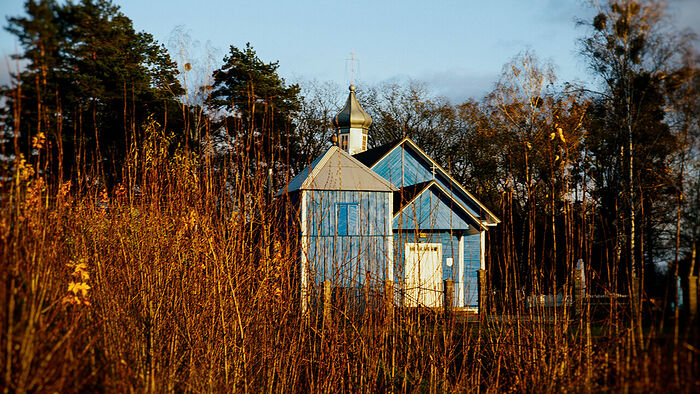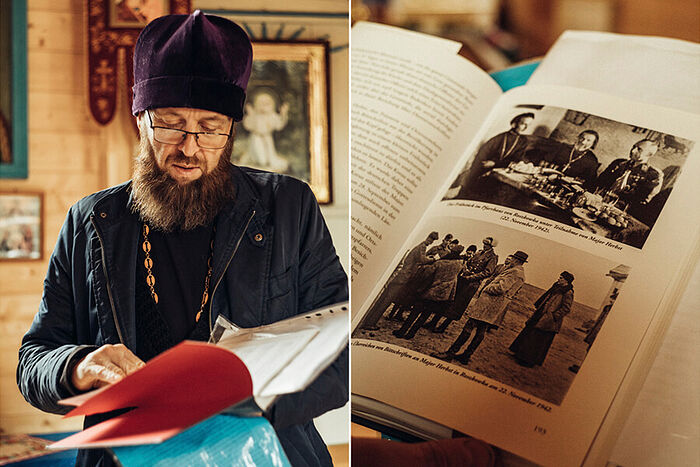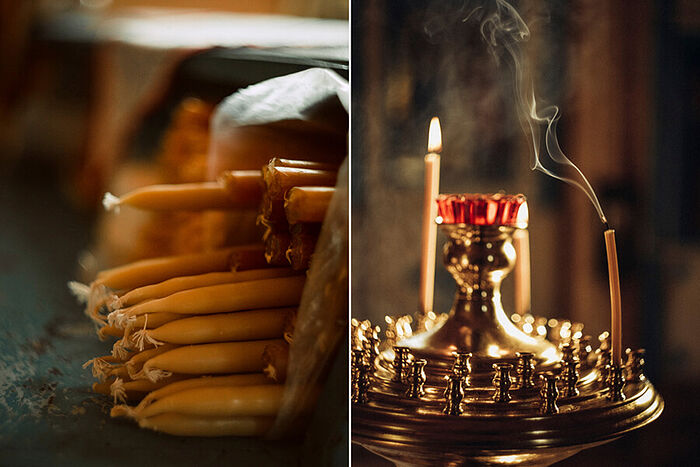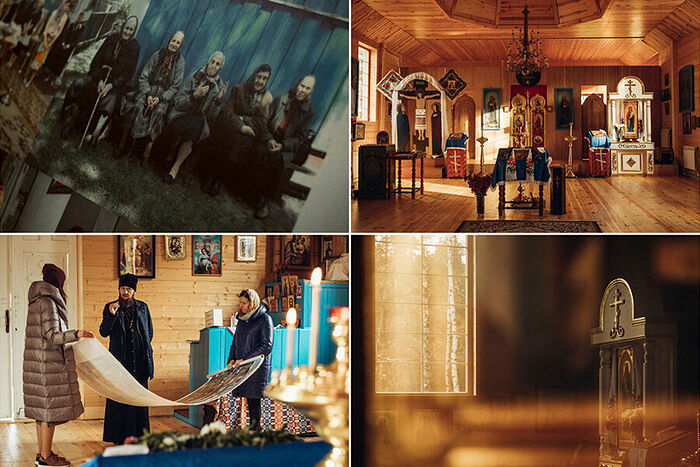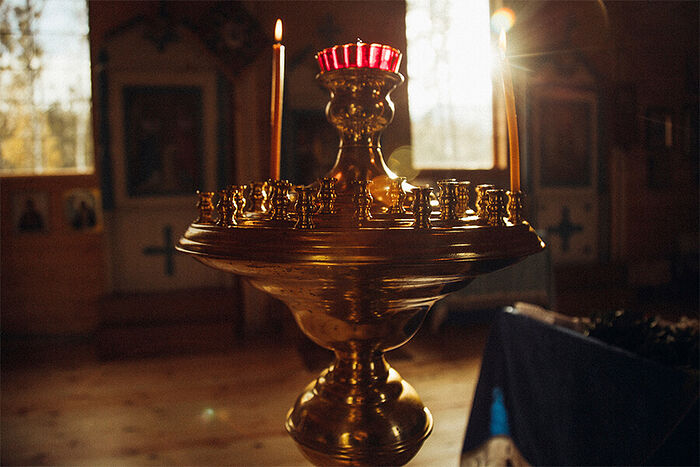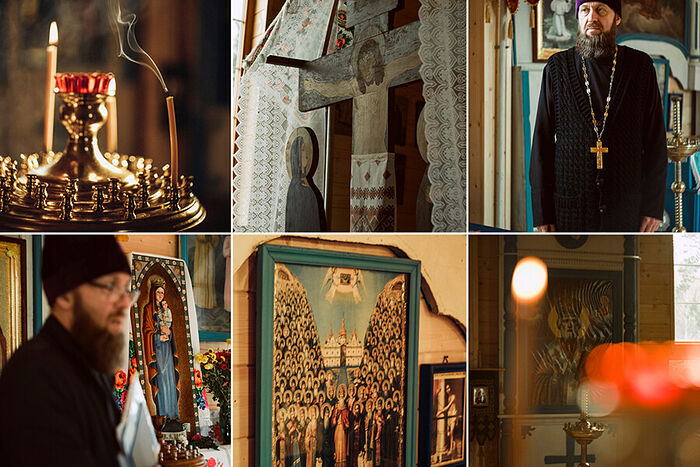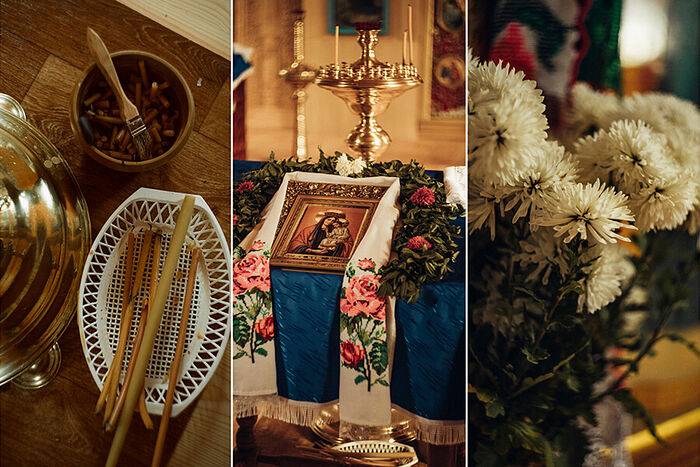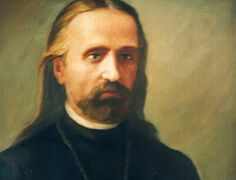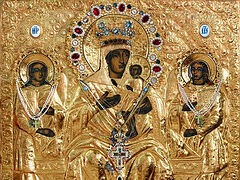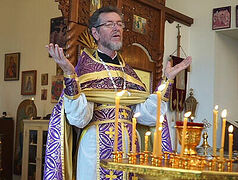In the Belovezhskaya Puscha, surrounded by forest on all sides, sits the small village of Rozhkovka. And on the edge of the village, by the road, sits the blue wooden Church of the Rozhkovka Icon of the Mother of God. A stone-paved street runs from the church through the village. It was along this street that Germans led the residents of the village off to be shot in 1942 for their connection with partisans. But miraculously, no one died… Only a few old folks live in Rozhkovka year-round now. Some of them experienced these tragic and at the same time miraculous events.
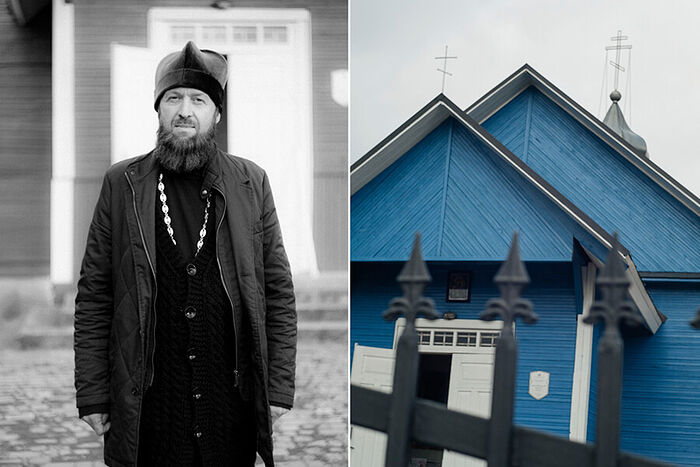 Fr. Igor Perkovsky, rector of the church
Fr. Igor Perkovsky, rector of the church
Execution
Fr. Igor Perkovsky, the rector of the church, came to Rozhkovka to open the church for us. He was born in a village not far away, and has been serving in the Rozhkovka church for twelve years now.
The church is closed on weekdays—there are only services here once every two weeks. Next to the church is a cemetery, an abandoned post office, and a former school. There are only a few older people living in the village now. This place is fenced off from the outside world by the mighty Puscha pines, and perhaps that’s why it’s so quiet and peaceful here. Time has frozen like a November fog, and the events of eighty years ago easily come to life in their memories.
“It was one of the biggest punitive operations in Belarus,” Fr. Igor tells us as he opens the door to the bright church smelling of fresh wood. “On the morning of September 28, 1942, all the residents of Rozhkovka were brought out to the firing pit and the death sentence was read out. Behind the village was a field, and behind the field an airfield. Soviet paratroopers who had killed several fascists had received shelter in the village, and they decided to execute the residents of the village as an example to others.
At that time, a German officer named Herbst—a Luftwaffe major—was flying over the village in a light-engine plane. His battalion was guarding the forest—the Reich’s hunting ground. He landed the plane, asked them to stop the execution, and flew to the headquarters in Białystok. A while later, he returned to the site of the planned execution with a document stating that the residents had been pardoned…
It’s hard to say now how it really was, but the people say that the Mother of God appeared to the German officer and said: “Stop the execution. They’re killing innocent people.”
“We found a report from the German officer Herbst in the German archives and translated it into Russian,” says Fr. Igor, showing us the text on a blue sheet of paper, and reading aloudan excerpt from it:
The following was planned. The village of Rozhkovka is being evacuated. All the children twelve years old and younger are being placed in the surrounding settlements. Girls from twelve to twenty-two years old and boys from twelve to seventeen years old will go to Germany to work. The other residents of the village will be shot.
Twenty-four residents of the settlement were absent. The pit was already prepared.
Of 632 residents, 264 should be shot on the spot.
Memory
In the Kamanetsk District’s book, Memory, there’s a testimony from the resident of the village, Maria Protasevich:
We started crossing ourselves, whispering prayers, and imagining we’d already died. We had no hope of being rescued from death. After about four hours, a plane landed near the field. After that, it took off and flew away. We were perplexed. Some continued praying and asking God for help. The executioners glanced at their watches… They were waiting for the plane to come back, and they were ready for a massacre. A roar was heard coming from the direction of the forest again. An officer got out of the plane waving a piece of paper around.
We all came to the big pit. The Germans ordered us to kneel in a semicircle. From the other end, the executioners were getting four machine guns ready for firing. In the presence of the German officer, one of the executioners recounted the order: “We’re not going to shoot you this time, but you see the pit’s been dug, and if you don’t stop communicating with partisans, you’ll be lying in it. We’ll return the children. Keep building the church.” For a long time, we couldn’t even believe that we were alive.
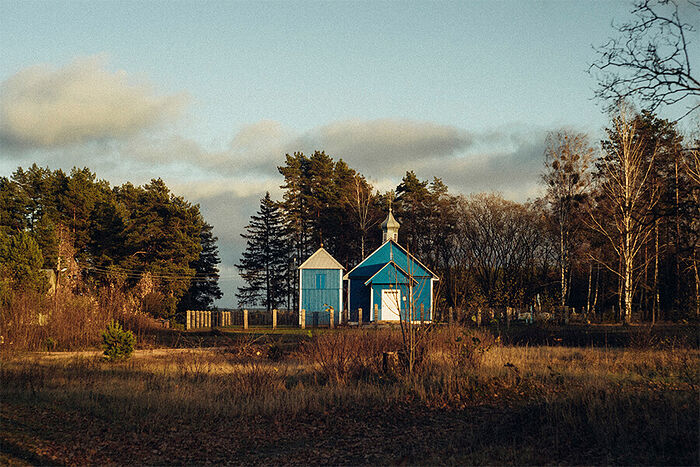 The Church of the Rozhkovka Icon of the Mother of God
The Church of the Rozhkovka Icon of the Mother of God
After this miracle, in the winter of 1943, the grateful people built a church, which they had begun even before these events. When the Germans destroyed the neighboring village of Beloe, they also burned down the Church of the Kazan Icon of the Mother of God. Therefore, the church in Rozhkovka was originally called the same, in honor of the Kazan Icon of the Mother of God.
And the German officer Herbst came to the opening of the church and promised to bring an icon of the Theotokos. And indeed, he ordered a copy of the Rozhkovka Icon of the Mother of God from a wounded German soldier who was being treated in the hospital in Belovezh. “He probably told the soldier how to do it, and described the vision to him,” Fr. Igor suggests.
This icon is made in the form of a bas-relief from a single piece of wood. The date of the event, 9/28/1942, is given at the bottom. Herbst personally brought this icon to the church.
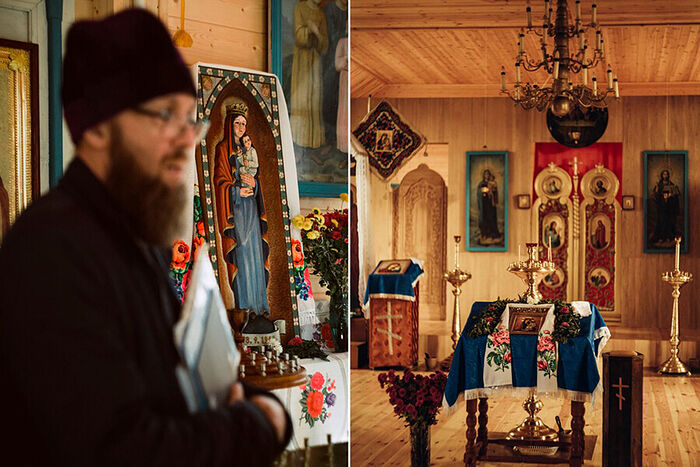 The Rozhkovka Mother of God, given to the church by Herbst
The Rozhkovka Mother of God, given to the church by Herbst
And there are rushniks1 from Rozhkovka at the home of Herbst. The locals gave them to him in gratitude for the rescue, and they’re still kept there.
“And when they had the Nuremberg trials of the fascists, Herbst was released home,” says Fr. Igor. “Despite the fact that he was an aviation major, he didn’t go to jail. He lived into old age and died a natural death. He has two sons and a daughter. The Mother of God ruled his life and that of his family.”
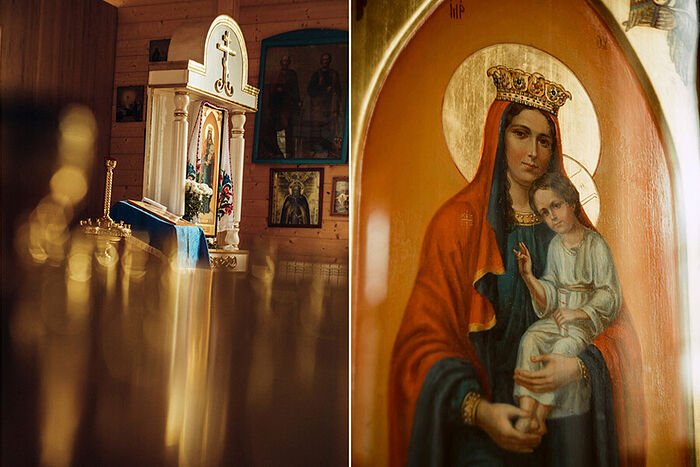 The icon of the Rozhkovka Protectress, painted by iconographers from St. Petersburg
The icon of the Rozhkovka Protectress, painted by iconographers from St. Petersburg
In 2008, Archbishop Ioann (Homa) consecrated the Church of the Rozhkovka Icon of the Mother of God. And in St. Petersburg, iconographers of the St. Alexander Nevsky Lavra painted an icon based on the wooden icon given to the church by the German officer, which they called the Rozhkovka Protectress, and gifted it to Rozhkovka.
The icon is painted on a board made from a pine that was growing on the grave of St. Seraphim of Vyritsa.
When do miracles happen?
Fr. Igor unrolls a large poster with photos of the villagers, the church, and everyday moments, and continues the story:
“The residents of this village were pious, very friendly, and lived as one family. Now the parish has eighty people—that’s from several villages. There are services every other Sunday. It seems as though there aren’t any people, but there’s always someone at the service. They’re all over eighty now. The youngest woman in the choir turned eighty two years ago—we celebrated her birthday. There’s life here. Someone always comes—someone always needs it.
“This is Olga Ivanovna,” he says, pointing to one of the babushkas on the poster. “Her mother and father were led out to be shot that day. They had two children—a seven-year-old boy and a two-year-old girl. Her mama was pregnant with her at the time. The children were taken away. The boy began to cry, and the girl grabbed her mama by the neck and wouldn’t let go. A German came running up, grabbed the girl by the legs, and threw her onto the cart. Her mother fainted. And when she opened her eyes, the German said: ‘Fine, just go,’ and let her go. And she gave birth that same day.
“Fr. Thomas Klyuka was serving when they built the church. You can only see his arm in the photo,” Fr. Igor says, pointing to the poster. “When the Germans retreated, the priests, realizing that the soviets would shoot them, started leaving with the families. Fr. Thomas got as far as Warsaw, and there he said: ‘I can’t do this,’ and returned to Rozhkovka. He lived here and developed the church life. Then he was arrested and given nine years in a camp.
“I think it was thanks to this miracle that he returned. I think it gave him confidence when he decided to return.
“When there were still more people living in the village who had been at the firing pit, no matter who I spoke with, they all had their own personal attitude to these events—everyone described the day differently.
“One of the local women told me this story. There didn’t used to be a church in Rozhkovka. The church was in the village of Beloe. In August 1941, the Germans evicted all the inhabitants of this village and burned it and the church. The people of Rozhkovka were working in the fields and saw that the church was on fire, so they left their work, ran to the church, but it was too late to put the fire out. It was entirely engulfed in flames. There were police there, and the residents asked for permission to enter the church. The request was translated for the German officer, and he said: “Get out of here!” And one woman, Olga Drachuk, said: “Uh huh!” and ran into the burning church. Several other women went with her, although they all had five or seven children. They grabbed the Royal Doors, icons, the antimension, and the liturgical vessels to be able to serve the Divine Liturgy. They kept all this at their houses, and when a church was built in 1943, they used these items. They went into the fire for God’s sake. Perhaps that’s why the Lord and the Mother of God saved them from being shot.
“When I heard this story, I realized: For me, this is the answer to the question of why a miracle happened here. But this answer is different for everyone.”
Where’s Kirkenes and where’s Rozhkovka?
Eleven miles from Rozhkovka lives a woman named Alexandra Onischuk. Despite the proximity, she learned about this story not from the locals, and not even from Belarusians, but from a young Russian family that had never even been in these parts. Strangely enough, few people really know about this miraculous story from a village in their own country.
“Do people know about this miracle in Belarus?” I ask Fr. Igor.
“A family from Minsk called me not too long ago. They had found an icon of the Rozhkovka Mother of God in a compost pile at their dacha. They’ve never been here. How the icon got there, no one knows.
“In Norway, there’s a small city called Kirkenes. The parishioners of the Church of St. Tryphon of Pechenga had heard about this miracle. Copies of the icon were distributed to everyone in the community. They had a girl who had blood problems, leukemia, and she prayed before this icon. Her parents took her for a blood analysis, and everything was fine. All the indicators returned to normal. Imagine, where’s Kirkenes, and where’s Rozhkovka?
“A classmate of mine came to our church. Her son was having health problems. They prayed before this icon, and everything got better... That’s just what comes to mind. So many good things are happening! Isn’t it a miracle when a family is preserved and continues on its path? In our times, that’s a miracle. And there are many such families that have been preserved thanks to the prayers of the Theotokos.

